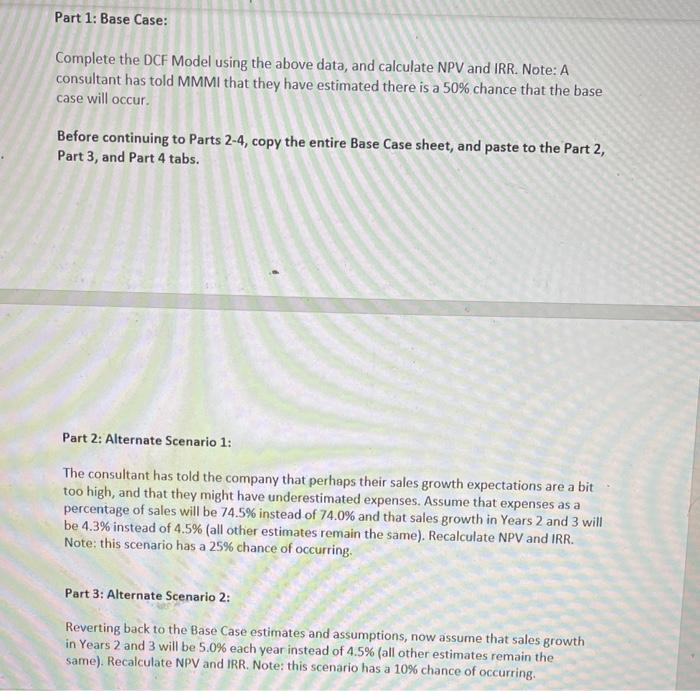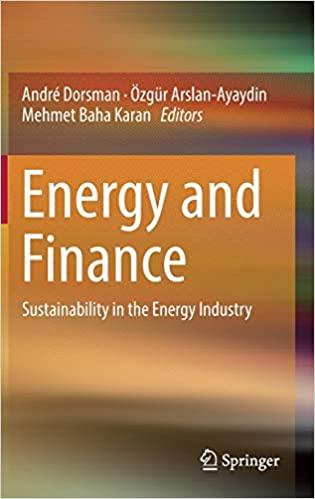


Mid-Michigan Manufacturing Inc. (MMMI) wishes to determine whether it would be advisable to replace an existing production system with a new automated one. They have hired you as a consultant to determine whether the new system should be purchased. The data you will need is as follows: MMMI has decided to set a project timeline of 4 years. The new system will cost $3,200,000. It will be depreciated (straight line) over a five- year period (its estimated useful life), assuming a salvage value of $200,000 the amount the company will be writing the new system down to over its five-year expected life). The old system, which has been fully depreciated, could be sold today for $506,329. The company has received a firm offer for the system from Williamston Widgets, and MMMI will sell it only if they purchase the new system. Additional sales generated by the superior products made by the new system would be $3,000,000 in Year 1. In Years 2 and 3 sales are projected to grow by 4.5% per year. However, in Year 4 sales are expected to decline by 10% per year as the market starts to become saturated. Total expenses have been estimated at 74.0% of Sales. The firm's tax rate 21%. MMMI requires a minimum return on the replacement decision of 8.5%. A representative from Stockbridge Sprockets has told MMMI that they will buy the system from them at the end of the project (the end of Year 4) for $600,000. MMMI has decided to include this in the terminal value of the project. The project will require $200,000 in additional Net Working Capital, 40% of which will be recovered at the end of the project. Part 1: Base Case: Complete the DCF Model using the above data, and calculate NPV and IRR. Note: A consultant has told MMMI that they have estimated there is a 50% chance that the base case will occur. Before continuing to Parts 2-4, copy the entire Base Case sheet, and paste to the Part 2, Part 3, and Part 4 tabs. Part 2: Alternate Scenario 1: The consultant has told the company that perhaps their sales growth expectations are a bit too high, and that they might have underestimated expenses. Assume that expenses as a percentage of sales will be 74.5% instead of 74.0% and that sales growth in Years 2 and 3 will be 4.3% instead of 4.5% (all other estimates remain the same). Recalculate NPV and IRR. Note: this scenario has a 25% chance of occurring. Part 3: Alternate Scenario 2: Reverting back to the Base Case estimates and assumptions, now assume that sales growth in Years 2 and 3 will be 5.0% each year instead of 4.5% (all other estimates remain the same). Recalculate NPV and IRR. Note: this scenario has a 10% chance of occurring. Part 4: Alternate Scenario 3: Revert back to the Base Case estimates and assumptions. Assume sales growth in Years 2 & 3 will be 4.3% instead of 4.5%, sales in Year 4 will only decline by 5% instead of 10%, and expenses as a percentage of sales will be 74.8% instead of 74.0% (all other estimates remain the same). Recalculate NPV and IRR. Note: this scenario has a 15% chance of occurring. Mid-Michigan Manufacturing Inc. (MMMI) wishes to determine whether it would be advisable to replace an existing production system with a new automated one. They have hired you as a consultant to determine whether the new system should be purchased. The data you will need is as follows: MMMI has decided to set a project timeline of 4 years. The new system will cost $3,200,000. It will be depreciated (straight line) over a five- year period (its estimated useful life), assuming a salvage value of $200,000 the amount the company will be writing the new system down to over its five-year expected life). The old system, which has been fully depreciated, could be sold today for $506,329. The company has received a firm offer for the system from Williamston Widgets, and MMMI will sell it only if they purchase the new system. Additional sales generated by the superior products made by the new system would be $3,000,000 in Year 1. In Years 2 and 3 sales are projected to grow by 4.5% per year. However, in Year 4 sales are expected to decline by 10% per year as the market starts to become saturated. Total expenses have been estimated at 74.0% of Sales. The firm's tax rate 21%. MMMI requires a minimum return on the replacement decision of 8.5%. A representative from Stockbridge Sprockets has told MMMI that they will buy the system from them at the end of the project (the end of Year 4) for $600,000. MMMI has decided to include this in the terminal value of the project. The project will require $200,000 in additional Net Working Capital, 40% of which will be recovered at the end of the project. Part 1: Base Case: Complete the DCF Model using the above data, and calculate NPV and IRR. Note: A consultant has told MMMI that they have estimated there is a 50% chance that the base case will occur. Before continuing to Parts 2-4, copy the entire Base Case sheet, and paste to the Part 2, Part 3, and Part 4 tabs. Part 2: Alternate Scenario 1: The consultant has told the company that perhaps their sales growth expectations are a bit too high, and that they might have underestimated expenses. Assume that expenses as a percentage of sales will be 74.5% instead of 74.0% and that sales growth in Years 2 and 3 will be 4.3% instead of 4.5% (all other estimates remain the same). Recalculate NPV and IRR. Note: this scenario has a 25% chance of occurring. Part 3: Alternate Scenario 2: Reverting back to the Base Case estimates and assumptions, now assume that sales growth in Years 2 and 3 will be 5.0% each year instead of 4.5% (all other estimates remain the same). Recalculate NPV and IRR. Note: this scenario has a 10% chance of occurring. Part 4: Alternate Scenario 3: Revert back to the Base Case estimates and assumptions. Assume sales growth in Years 2 & 3 will be 4.3% instead of 4.5%, sales in Year 4 will only decline by 5% instead of 10%, and expenses as a percentage of sales will be 74.8% instead of 74.0% (all other estimates remain the same). Recalculate NPV and IRR. Note: this scenario has a 15% chance of occurring









